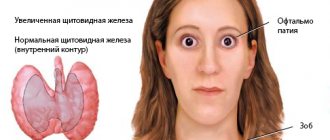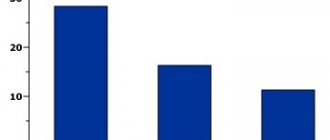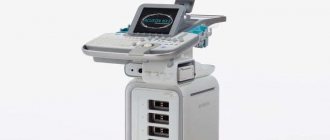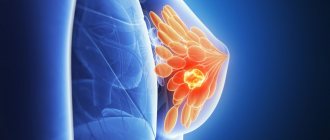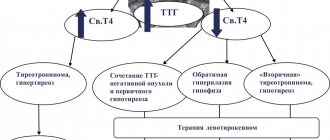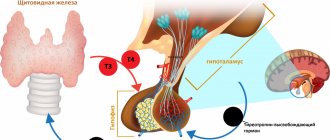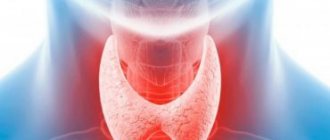Acute and subacute thyroiditis.
Typically develop after a viral or bacterial infection. Acute thyroiditis can be purulent or non-purulent. Acute purulent thyroiditis develops due to the presence of a focus of chronic infection, after suffering tonsillitis, periodontitis, pneumonia, etc.
The clinical picture begins acutely and is characteristic of the inflammatory process: swelling of the gland (enlargement and pain on palpation), severe pain radiating to the lower jaw, neck, increased body temperature, chills, severe asthenia.
Laboratory examination reveals inflammatory changes in the general blood test (increased leukocyte levels, changes in the leukocyte formula, acceleration of ESR). When examining hormonal status, most often no changes are detected, but a picture of thyrotoxicosis is possible. An ultrasound of the thyroid gland reveals signs of inflammation and increased blood circulation in the gland.
Treatment: rest, antibiotic therapy, anti-inflammatory therapy with NSAIDs, identification and treatment of the source of infection.
Acute non-purulent thyroiditis is the result of trauma, hemorrhage into the gland, irradiation of the head and neck organs (post-radiation thyroiditis). It begins some time after exposure and is less acute. Treatment consists only of NSAIDs and sometimes glucocorticoids.
Subacute thyroiditis (De Quervain's thyroiditis) begins less acutely than acute thyroiditis. The cause is a viral infection. Women get sick more often.
The clinical picture is also characterized by signs of local inflammation, asthenia, pain, chills, fever to subfebrile, sometimes with signs of thyrotoxicosis. If treatment is started in a timely manner, the inflammation goes away quickly and without consequences.
Laboratory changes are characteristic of o.thyroiditis, but less pronounced.
Treatment: anti-inflammatory therapy with NSAIDs or glucocorticoids, symptomatic treatment of manifestations of thyrotoxicosis.
As a result of suffering from thyroiditis, hypothyroidism can develop, therefore, after acute and subacute thyroiditis, it is recommended to observe for 6 months with a study of hormonal status, antibody levels and ultrasound.
Hyperthyroidism
If the cause of goiter is increased thyroid function (increased amount of thyroid hormones), it is called diffuse toxic goiter, or hyperthyroidism. Symptoms are similar to thyrotoxicosis. Among the characteristic signs are sudden weight loss, disrupted functioning of the gastrointestinal tract (more frequent stools, nausea and vomiting). In addition, the person becomes irritable, his sleep deteriorates, he often has a headache, and dizziness appears.
External signs of hyperthyroidism are the presence of shiny, protruding eyes, a person’s hands tremble, and a goiter is visible to the naked eye. Also, there is an increase in heart rate, an increase in systolic pressure and a decrease in diastolic pressure. Arrhythmia may develop. In most cases, there is a sharp pain in the muscles.
Chronic autoimmune thyroiditis
Chronic autoimmune thyroiditis (CAIT) is an inflammatory disease of the thyroid gland associated with impaired functioning of the immune system. It is characterized by the formation of specific autoantibodies that have a destructive effect on thyroid cells. The latter occurs due to a malfunction of the immune system, which perceives its own tissues as foreign.
The result of a long course of chronic autoimmune thyroiditis is hypothyroidism, which is expressed in a persistent lack of thyroid hormones in the blood, which requires immediate replacement therapy. Women are more often affected.
You can undergo a course of treatment for this disease at the CELT multidisciplinary clinic.
Our endocrinologists have effective means to restore our patients to health.
Thyroid gland - structure
At the cellular level, the thyroid gland consists of three types of cells: A cells (thyrocytes, follicular cells) synthesize thyroid hormones, B cells (Ashkinazi cells) synthesize biogenic amines (serotonin) and C cells (parafollicular) synthesize calcitonin.
When examined under a microscope, you can see the structure of the thyroid gland:
- follicle cavity filled with colloid
- follicle wall, formed by thyrocytes
- blood vessel
- parafollicular cells, C cells
Etiology
Like any autoimmune disease, chronic autoimmune thyroiditis is based on a defect in the genes responsible for the production of specific autoantibodies. As a rule, these changes are determined in the form of polymorphisms, the pathological effect of which is initiated by environmental factors:
- negative impact of polluted environmental factors;
- use of interferon;
- infectious and viral diseases;
- uncontrolled long-term use of iodine-containing drugs
- radiation exposure.
There is also a hereditary predisposition to the development of CAIT. Most often, girls whose mothers already suffer from this pathology are affected.
Hypothyroidism
If the cause of the disease is decreased thyroid function (hypothyroidism), it is a hypothyroid goiter. The development is associated with chronic thyroiditis and treatment of thyrotoxicosis. Also, the cause may be a congenital anomaly. Among the signs are the appearance of chilliness regardless of weather conditions, excessive weakness, fatigue, and constipation.
Hypothyroidism is characterized by the development of mental retardation, decreased attention, forgetfulness, and depression may develop. A woman with this diagnosis experiences disruption of her menstrual function and is unable to conceive or bear a child. The skin becomes dry, the fragility of hair and nails increases. The face, shoulders, and legs swell.
If you press on the swollen area, a hole will not appear and the skin will not gather into a fold. This phenomenon is called myxedema (a mucous, mucopolysaccharide-rich substance accumulates). Swelling of the tissues causes damage to the sensory organs - vision, hearing are impaired, the voice is low, the person begins to snore at night. Among the external signs one can highlight the presence of a round moon-shaped face, dry pale skin, and sparse hair.
Hypothyroidism is a common condition where insufficient amounts of thyroxine are produced. This situation is dangerous due to serious metabolic disturbances. If you contact the clinic in a timely manner, this can be quickly corrected using modern means.
Clinical manifestations
The debut of CAIT does not have a specific clinical picture. The onset of an autoimmune process, as a rule, does not have any clinical manifestations at all and is therefore detected either by chance during an ultrasound of the thyroid gland, or is suspected during an appointment with an endocrinologist during palpation of the thyroid gland. During the collection of complaints, the patient may pay attention to mild apathy or nervousness, general weakness or headaches or other autonomic disorders.
As a result of prolonged autoimmune inflammation, protective factors weaken and gland cells begin to destroy, which affects the patient’s well-being. During this period, the clinical picture depends on changes in thyroid function. Basically, the result of the autoimmune process is hypothyroidism, but sometimes the debut of the clinical stage of CAIT begins with thyrotoxicosis. Then the patient notes:
- increase in the above symptoms;
- feeling of heat throughout the body, increased sweating;
- constant heartbeat;
- trembling in hands;
- loss of body weight against the background of increasing appetite;
- disruptions of the menstrual cycle in women, decreased libido in men;
- an increase in the volume of the neck caused by the growth of the thyroid gland.
For hypothyroidism:
- fatigue, drowsiness;
- swelling of the face and legs;
- increased blood pressure and decreased heart rate;
- constipation;
- enlargement of the neck above the jugular fossa.
Most often, changes in thyroid function during CAIT occur according to the following scheme: euthyroidism - thyrotoxicosis - euthyroidism - hypothyroidism. But sometimes the phase of thyrotoxicosis is so short-lived that it cannot be diagnosed
CJSC "ENDOCRINOLOGICAL CENTER"
Rice. 1 - Location of the thyroid gland in humans
EUTHYROID GOITER
Euthyroid goiter (endemic goiter) is an enlargement of the thyroid gland, with normal hormone levels.
Why does the thyroid gland enlarge?
The fact is that the thyroid gland produces two hormones: triiodothyronine (contains 3 iodine molecules) and thyroxine (contains 4 iodine molecules). Iodine is a trace element that is not produced in the body, so we must get it daily. Therefore, no iodine means no hormones, little iodine means few hormones. However, our body requires as many hormones as it should, otherwise disturbances in all metabolic processes (protein, carbohydrate, fat, water, etc.) begin. When there is a deficiency, stimulation of the thyroid gland function by TSH (thyroid-stimulating hormone, which is produced by the pituitary gland) is triggered, as a result of which, by increasing the size of the thyroid gland, a relative stabilization of hormone production is achieved.
Rice. 2 - Enlarged thyroid gland
Why is iodine deficiency dangerous?
According to WHO (World Health Organization), populations living in regions with iodine deficiency have iodine deficiency diseases. These are dysfunctions of the immune system, autoimmune diseases of the thyroid gland, among children - an increased frequency of colds, a higher percentage of children with decreased mental abilities, and the birth of children with congenital hypothyroidism. The most socially significant iodine deficiency disease is a decrease in the intellectual potential of the population in regions where goiter is endemic, etc.
With prolonged iodine deficiency, so-called hypothyroxinemia develops, i.e. decrease in hormone levels during physical and emotional stress, pregnancy, viral diseases, etc. With hypothyroxinemia, thyroid function decreases, which leads to:
- Frequent colds and viral infections, their more severe course;
- During puberty, the thyroid gland enlarges and nodular goiter forms;
- Menstrual dysfunction, both in adolescence and in adult women, hormonal dysfunction in both women and men; during pregnancy, it negatively affects the development of the brain in the fetus;
- Development of autoimmune thyroid diseases.
Research by world scientists has proven that the role of maternal thyroid hormones in the early stages of pregnancy plays a large role in the formation of the intelligence of future offspring. According to scientific research, indicators of mental development of children living in conditions without iodine deficiency are 15-18% higher than in iodine-deficient conditions. In this regard, it is believed that long-term living of people in conditions of iodine deficiency (if the population does not take additional iodine in the form of iodized salt or iodine preparations) leads to a slow decline in the level of intelligence of the entire population living in a given area.
What kind of prevention should be done to prevent iodine deficiency diseases?
In conditions of goiter endemia it is necessary:
- Preventive intake of iodine daily and constantly, regardless of the time of year and other factors! This is iodized salt or preparations containing prophylactic doses of iodine (sometimes both).
- Ultrasound of the thyroid gland, taking into account the correct assessment of the tissue structure and nodular formations. However, the size of the thyroid gland is assessed by a doctor by palpation, since the volume of the thyroid gland by ultrasound does not (often) correspond to the size of the examined thyroid gland by palpation. These conclusions were made at the congress on thyroid diseases in Moscow.
- Determination of thyroid hormones and evaluation of results by an endocrinologist.
- Observation and treatment in case of detection of iodine deficiency diseases (doctor's recommendations).
Is there iodine deficiency in the conditions of the Irkutsk region?
Almost the entire territory of Russia belongs to regions with insufficient iodine content in the environment. Studies have shown that the actual average iodine intake currently ranges from 40 to 80 mcg per day, which is 3 times less than the recommended amount.
The Irkutsk region belongs to an iodine-deficient region. There is no iodine in Baikal water, and, consequently, in the Angara, and in the plants that grow on our land.
Until now, iodized salt is not regularly available in stores and only a small part of the population uses it. In this connection, mass iodine prophylaxis should be organized: only iodized salt is on sale and, in addition, iodization of other products (bread, dairy products).
In the absence of such conditions, we need to take medications with a prophylactic dose of iodine - iodomarin, iodine balance. For adults, 200 mcg of iodine per day is enough. Remember, these doses of iodine prophylaxis are completely harmless and do not accumulate in the body. Iodomarin, the iodine balance in these doses, can be considered to provide those doses of iodine that we could replenish with iodized salt. Therefore, these drugs can be taken at any age and for any form of goiter (diffuse, nodular).
Daily iodine requirement
| Groups of people | Iodine requirement (mcg/day) |
| Preschool children (0-59 months) | 90 |
| School age children (6-12 years old) | 120 |
| Teenagers over 12 years old and adults | 150-200 |
| Pregnant and lactating women | 250 |
There is an opinion that in case of nodular forms of goiter over the age of 60 years, taking iodomarin is contraindicated. Let's imagine that we have iodine prevention of goiter (as in other countries). And the entire population takes iodized salt regularly. If we proceed from the position of far-fetched contraindications, it turns out that people with nodular goiter and over 60 years of age should not consume iodized salt? Of course not!
In our country, only 30% of the population consumes iodized salt, so in our country it is important to use pharmaceuticals containing (unlike dietary supplements) a strictly defined amount of iodine (for example, iodomarin, iodine balance).
Iodomarin, iodine balance are undesirable in persons with thyrotoxicosis and in persons who have low levels of thyroid-stimulating hormone. These issues should be discussed with your doctor.
The use of iodine solutions and various ointments with iodine is absolutely contraindicated! since the iodine content in them significantly exceeds prophylactic doses, which can lead to disruption of thyroid function. Consumption of algae also does not provide complete prevention, since there is no specific dosage, and therefore it is impossible to determine the required amount of iodine.
REMEMBER: we need thyroid hormones from birth to old age if we want to maintain our intelligence! Therefore, recommendations that preventive doses of iodine should not be taken after 50-60 years are unacceptable in the conditions of our region!
NODUAL GOITTER
It is currently believed that the main cause of nodules in the thyroid gland is a chronic lack of iodine in food. The presence of a sufficient amount of iodine in the thyroid gland blocks growth factors, and therefore nodules rarely form. With a lack of iodine, individual areas of the thyroid tissue grow.
Nodules are benign tumors that have the ability to grow, pushing apart the surrounding thyroid tissue. At the same time, benign cells do not acquire the ability for infiltrative growth (i.e., penetration between thyroid cells), like malignant ones. Benign tumors can cause symptoms of compression of surrounding organs in the patient (for example, compression of the nearby trachea can lead to difficulty breathing), but are not capable of metastasizing, i.e. spread through the bloodstream to other organs.
What should be done when nodular formations are detected?
- Ultrasound of the thyroid gland. When performing an ultrasound, the location, quantity, shape, size and other parameters of the node are assessed.
- Ultrasound-guided fine-needle aspiration biopsy (abbreviated FNA). This procedure answers the question: is the node benign or malignant.
Fig.3. Fine needle aspiration biopsy of the thyroid gland
- Determination of thyroid hormone levels. If thyroid-stimulating hormone (TSH) decreases, it is necessary to perform thyroid scintigraphy. Particular cases of TSH levels depend on the quality of the tests by which it is determined. These tests may not be “sensitive” enough; in these cases, the doctor must evaluate the clinical symptoms and conduct repeated tests.
It should be noted that when benign nodes are identified, dynamic monitoring is required: twice a year, ultrasound of the thyroid gland and determination of thyroid hormones. If the size of the node increases, a repeat puncture biopsy is performed.
Modern approaches to the treatment of nodular forms of goiter (benign):
In case of benign nodular goiter, it is necessary to assess the functional activity of the node, i.e. determination of TSH. If the TSH level is reduced, then it is necessary to exclude the functional activity of the node (carrying out thyroid scintigraphy). If the TSH level is normal, dynamic monitoring of the growth of nodes and taking medications containing preventive doses of iodine (iodomarin, iodine balance) are recommended.
Surgical treatment of benign nodes currently has strict indications. According to international and Russian recommendations for the diagnosis and treatment of nodular goiter, indications for surgery are:
- tracheal compression syndrome established on the basis of CT;
- functional autonomy with manifest or subclinical thyrotoxicosis when treatment with radioactive iodine is impossible;
- a cosmetic defect that reduces the quality of life.
In other cases, surgical treatment is NOT INDICATED!
Malignant nodes are subject to mandatory surgical treatment and, most importantly, timely treatment!
What consequences do we have in the postoperative period (after surgical treatment of benign nodes)?
- Reduction in the size of the thyroid gland and a decrease in its hormonal function, i.e. the development of hypothyroidism, requiring hormone replacement therapy, which will never replace the true hormones produced by the thyroid gland. We must not forget about combination therapy, i.e. hormonal plus preventive doses of iodine, which “feed” the remaining thyroid tissue.
- The growth of nodules can often recur after surgical removal of nodules in the remaining thyroid tissue and even on the remaining “stump,” since the entire thyroid gland “sicks” from nodulation. This is why it is dangerous to operate on benign nodes.
- During surgery, damage to the recurrent nerve is possible, which leads to weakening of the voice, hoarseness, and even complete loss of voice.
- Damage to the parathyroid glands, which regulate the exchange of calcium and phosphorus in the blood. Which, in turn, is accompanied by disruption of metabolic processes in bone tissue and requires replacement therapy.
New methods for treating benign nodes
Significant progress in the technical capabilities of endocrine surgery over the past 30 years has led to the widespread development of ultrasound examination, the introduction of fine-needle aspiration biopsy into practice, and the emergence of techniques that can eliminate problems associated with thyroid nodules without surgery. These techniques are called minimally invasive or interstitial destruction methods.
Among the destruction methods, the most widespread is the use of ethanol sclerotherapy - the introduction of ethyl alcohol into the tissue of the nodes. This method was one of the first to be introduced into clinical practice in the late 80s of the twentieth century by the Italian endocrinologist T. Livrani. The greatest effect was noted from the use of laser (laser-induced thermotherapy).
Interstitial methods are aimed at destroying nodes inside the thyroid tissue and are carried out under ultrasound control. The use of modern ultrasound devices allows the endocrinologist surgeon to work with high precision on the node that is the source of the patient’s problems. The main goal of such treatment is to destroy the tissue of the nodes without damaging the surrounding healthy tissue. Destruction of the node leads to a decrease in its size, and subsequently to the growth of the node, which makes it possible to avoid surgical treatment.
Minimally invasive methods have a number of advantages compared to surgical treatment. Firstly, they allow the patient to avoid surgery and everything associated with it - stress, anesthesia, a scar on the neck, relapse - i.e. the appearance of nodules on the remaining thyroid tissue. Secondly, it allows you to preserve the thyroid tissue surrounding the node, and therefore avoid the occurrence of hormonal deficiency after treatment. Thirdly, many minimally invasive techniques are used on an outpatient basis and without hospitalization, which allows the patient to work during treatment. This treatment is cheaper than surgery.
Minimally invasive techniques have proven to be especially useful for patients in the older age group. The occurrence of nodes in older people is almost normal - after 60 years of life, nodes appear in most people. In many patients, by the age of 70–80, these formations reach significant sizes and lead to complaints.
The main feature of all these techniques is the fact that the thyroid nodule is not removed during treatment. The tissue of the node is destroyed, but the node itself remains in place. After treatment, the volume of the node is usually significantly reduced. However, promising that the node will completely disappear means deceiving the patient. But most importantly, the node does not grow and does not function!
Examples from our practice
- Pregnancy and nodular goiter. Pregnancy, as a rule, stimulates the growth of the node, and therefore laser destruction is indicated.
- Substernal goiter with symptoms of compression, a history of myocardial infarction. The operation is contraindicated. When performing laser destruction, we obtain a reduction in the size of the node and the disappearance of symptoms of compression.
- In the absence of the possibility of proper dynamic observation, which is often the case, laser destruction will improve the situation.
Our center uses minimally invasive treatment methods: sclerotherapy and laser destruction. There is a specialist, Andrey Viktorovich Zybin, who has been trained in central clinics and has a certificate in the use of minimally invasive techniques. Over a long period of work, there are good results from their use.
THYROID AND PREGNANCY (3)
During pregnancy, women develop another so-called “endocrine gland” - the placenta, which creates a certain condition necessary for the development of the fetus. The level of many hormones increases, which, although bound to proteins, create the necessary “depot reserve”.
In women living in conditions of iodine deficiency, the thyroid gland cannot secrete hormones in reserve due to the lack of necessary iodine intake. “Nature,” responsible for the development of the fetus, does not recognize this and takes what the mother has into the depot. Thus, a mother living in conditions of iodine deficiency does not have sufficient amounts of either hormones or iodine, which are necessary for the normal development of the fetus and for her own body. In this regard, stimulation of the thyroid gland with thyroid-stimulating hormone (TSH) and placental hormones begins. What do we get if we do not take additional iodine supplements or thyroid hormones? A woman’s thyroid gland enlarges; if there are nodules, they can also enlarge, new nodes appear, and their malignant degeneration is possible.
Insufficiency of thyroid hormones affects the development of chronic placental insufficiency - a violation of the functional activity of the placenta, which leads to the threat of miscarriage or frozen pregnancy.
In addition, a negative effect of insufficiency of thyroid function on the fetus has been noted: chronic intrauterine hypoxia, disorders of brain formation (from decreased intelligence to cretinism), congenital hypothyroidism, often damage to the central nervous system (hydrocephalus), Down syndrome, etc.
Conclusion: it should be remembered that many disorders of the gonads in conditions of endemic goiter depend on the functional state of the thyroid gland.
Remember: an experienced endocrinologist can evaluate thyroid function based on clinical manifestations. A one-time assessment of hormone levels alone is insufficient and not informative.
When planning a pregnancy in conditions of endemic goiter (i.e., iodine deficiency, which exists in the Irkutsk region, Buryatia and other regions), it is necessary:
- Detailed examination of thyroid function
- Ultrasound diagnostics by highly qualified specialists who know all the intricacies of the thyroid structure in the presence of goiter and other thyroid diseases
- Determination of hormones
- Consultation with an endocrinologist with clinical experience in order to correctly assess ultrasound data and hormone levels (to exclude hypothyroxinemia - “hidden” symptoms of thyroid dysfunction)
- Dynamic determination of hormones during pregnancy
- Dynamic control over the size of nodular formations, if any
- Monitoring the state of the cardiovascular system in the presence of thyroid diseases Consequently, iodine deficiency during pregnancy leads to pathological changes, characterized by a decrease in the level of hormones and iodine in both the mother and the fetus and, accordingly, to obvious pathological disorders. The functioning of the thyroid gland in the fetus is completely dependent on the supply of iodine and hormones from the maternal body. With iodine and hormone deficiency, the function of the fetal thyroid gland is disrupted, which leads to disruption of the child’s brain formation (from decreased intelligence to cretinism), personality formation, damage to the central nervous system, etc.
HYPOTHYROIDOSIS (decreased thyroid function) (4)
Hypothyroidism affects all types of metabolism: protein, water, carbohydrate, fat. Characterized by damage to connective tissue (joint pain, osteoporosis, etc.), fluid retention (edema, increased blood pressure), inhibition of the function of the central nervous system, adrenal glands, and gonads. The development of mastopathy is possible. In children and adolescents – growth retardation, impaired physical and sexual development: menstrual dysfunction in girls, delayed sexual development in boys. Long-term hypothyroidism leads to an increase in prolactin levels and the development of a pituitary tumor, a decrease in the hormonal function of the adrenal glands, etc.
Causes of hypothyroidism:
- Lack of iodine in the body
- Endemic goiter
- Surgical interventions on the thyroid gland
- The most common cause is autoimmune thyroiditis
Autoimmune thyroid diseases are associated with dysfunction of the immune system due to iodine deficiency. Immune system disorders are accompanied by the formation of substances (antibodies), which in some cases “kill” the cells of the thyroid gland and autoimmune thyroiditis (AIT) develops with insufficiency of the thyroid gland (i.e. hypothyroidism). As a result, we have both non-functioning cells and preserved ones, which require the presence of iodine in the body to function.
Diagnostics:
Often, patient complaints may be the only symptoms of the disease:
- Fatigue
- Lethargy
- Drowsiness (more often during the day)
- Decreased physical or mental activity
- Decreased performance
- Memory loss
- Mood changes
With hypothyroidism, many body systems are damaged: the cardiovascular, nervous system, musculoskeletal, excretory and others.
From the nervous system: perception and attention decrease, mental activity slows down, mood lability, at times there is a feeling of fussiness, internal tension, increased sensitivity, vulnerability. I feel especially bad in the morning - a feeling of inner emptiness and heaviness. In contrast to neuroses, patients often complain of difficulty articulating, awkward movements, heaviness in the muscles, bones, and joints. With a slower progression of the disease, the following is noted: a tendency to conflicts, increased excitability - patients become “grumpy”, “angry”, and a quarrelsome character appears. Mental disorders progress, which are expressed in slowing down and difficulty in mental functioning.
Patients note weight gain, increased sensitivity to cold, voice changes, and menstrual irregularities. Dermatological symptoms are characteristic: hair loss, alopecia, dry skin, hyperkeratosis, nail damage. Therefore, any disease of the skin or hair requires examination of the function of the thyroid gland.
The disease can occur atypically or with minor symptoms, for example, with a predominance in the clinic of any group of symptoms: edema, cardiac symptoms, symptoms of the nervous system or psyche, muscle weakness.
The variation of symptoms can be varied. Patients are often treated by many specialists without knowing about their disease.
Remember! You live in conditions of iodine deficiency - it is necessary to periodically check the function of the thyroid gland. But this should be done not on the basis of the conclusion of an ultrasound diagnostic doctor, but of an endocrinologist.
Hypothyroidism in children: The clinical picture of hypothyroidism in children depends on age. For newborns it is typical: weight more than 4 kg, the child sucks poorly at the breast, lethargy, difficulty in nasal breathing, delayed mental development. At an older age: delayed physical and mental development, stunted growth (especially pronounced at 3-4 years).
Treatment of hypothyroidism consists of taking thyroid hormone drugs, but not as a treatment, but as a replacement for the deficiency of hormones that “did not supply” the damaged thyroid cells, plus necessarily preventive doses of iodine for the functioning of the cells. In children, the earlier treatment is started, the more reliably intellectual development will be preserved.
The course of the disease is progressive, which requires long-term observation and dose adjustment of hormones.
DIFFUSE TOXIC GOITER
Another autoimmune disease includes diffuse toxic goiter. With this disease, antibodies are formed that stimulate the functioning of thyroid cells; as a result, thyroid hormones are synthesized in excess and enter the blood. This condition is called thyrotoxicosis. Characteristic symptoms of thyrotoxicosis: increased excitability, palpitations, sweating, weight loss, trembling in the hands and body, and in older people - an unreasonable disruption of the heart rhythm.
Rice. 5. Symptoms of thyrotoxicosis
Treatment. There are three methods of treating this disease: this is the prescription of drugs that “block” the production of thyroid hormones; surgical treatment; radioactive iodine therapy.
It is necessary to take this disease seriously, since violation of the drug regimen, inaccessibility of frequent monitoring by an endocrinologist, long-term treatment (continuity of treatment for up to a year), and unreasonable combination of treatment with drugs that block the function of the thyroid gland with thyroid hormones leads to frequent relapses of the disease.
SUBACUTE THYROIDITIS (5)
The provoking factor is infection. Clinical picture: pain in the neck (usually in the thyroid gland) radiating to the back of the head, upper and lower jaw, high temperature, etc.
Rice. 6. Clinical picture of subacute thyroiditis
Treatment is the use of adrenal hormones (prednisolone).
We have developed a technique (Zybina V.D.) - local administration of hormones, which allows the use of small doses of hormones and a short period of treatment.
OPHTHALMOPATHY OR POGGY EYES
Rice.
7. Clinical picture of ophthalmopathy Often develops against the background of thyroid diseases.
An examination by an endocrinologist is necessary.
Zybina V.D. Associate Professor, Ph.D.
Why does thyroid function deteriorate?
Stress. Prolonged or regular stress has a negative impact on the brain, which, in turn, can send incorrect signals to the thyroid gland. In addition, any disruption of the gland, which is caused by another reason, is a provoking factor of stress. A person's emotional state deteriorates. In such a situation, it is necessary to determine whether a thyroid gland failure caused stress or a stressful condition led to organ failure.
Food. The thyroid gland is strongly affected by any toxic load. Therefore, foods that contain preservatives, nitrates, pesticides or other toxins can cause dysfunction. In addition, food not rich in vitamins, minerals, proteins, fats, carbohydrates can cause the gland to begin to produce hormones in insufficient quantities.
For normal functioning of the thyroid gland, iodine is necessary. The daily amount of iodine that should enter the body is about 200 micrograms. You can get it from food. It must only be organic. You should eat seaweed, sea fish, seafood, persimmons, and walnuts. The iodine contained in salt is not absorbed by the body. And if the salt is heated, it evaporates. It should be remembered that for the absorption of iodine, selenium and zinc must be present. Regular cabbage and all its varieties help bind iodine.
Drink. Synthetic energy tonic causes depletion of a certain part of the brain and adrenal glands, as a result of which the functioning of the thyroid gland is disrupted.
Viruses and parasites. In the presence of herpes, cytomegalovirus, streptococcus, staphylococcus, the functioning of the thyroid gland is greatly impaired. This is explained by the anatomical location of the gland. The tonsils are located next to the thyroid gland. With tracheitis, sore throat, sinusitis, pharyngitis, tonsillitis, the infection also penetrates the thyroid gland.
Bad habit. Abuse of alcoholic beverages, smoking, and toxic substances contribute to an increase in the toxic load, as a result of which the thyroid gland is endangered.
Sex hormones. A decrease or surge in estrogen provokes a change in the structure of the organ. The thyroid gland becomes more sensitive to TSH. Not only the size, but also the structure of the thyroid gland and the production of hormones depend on this hormone. Women over 50 should undergo regular hormone testing.
In case of strong radiation or prolonged stay in a place where the level of radiation is increased.
If there is not enough physical activity. This factor is not direct, but rather indirect. Failure to maintain an active lifestyle causes the blood to become thicker and less oxygenated. As a result, redox processes are disrupted.
